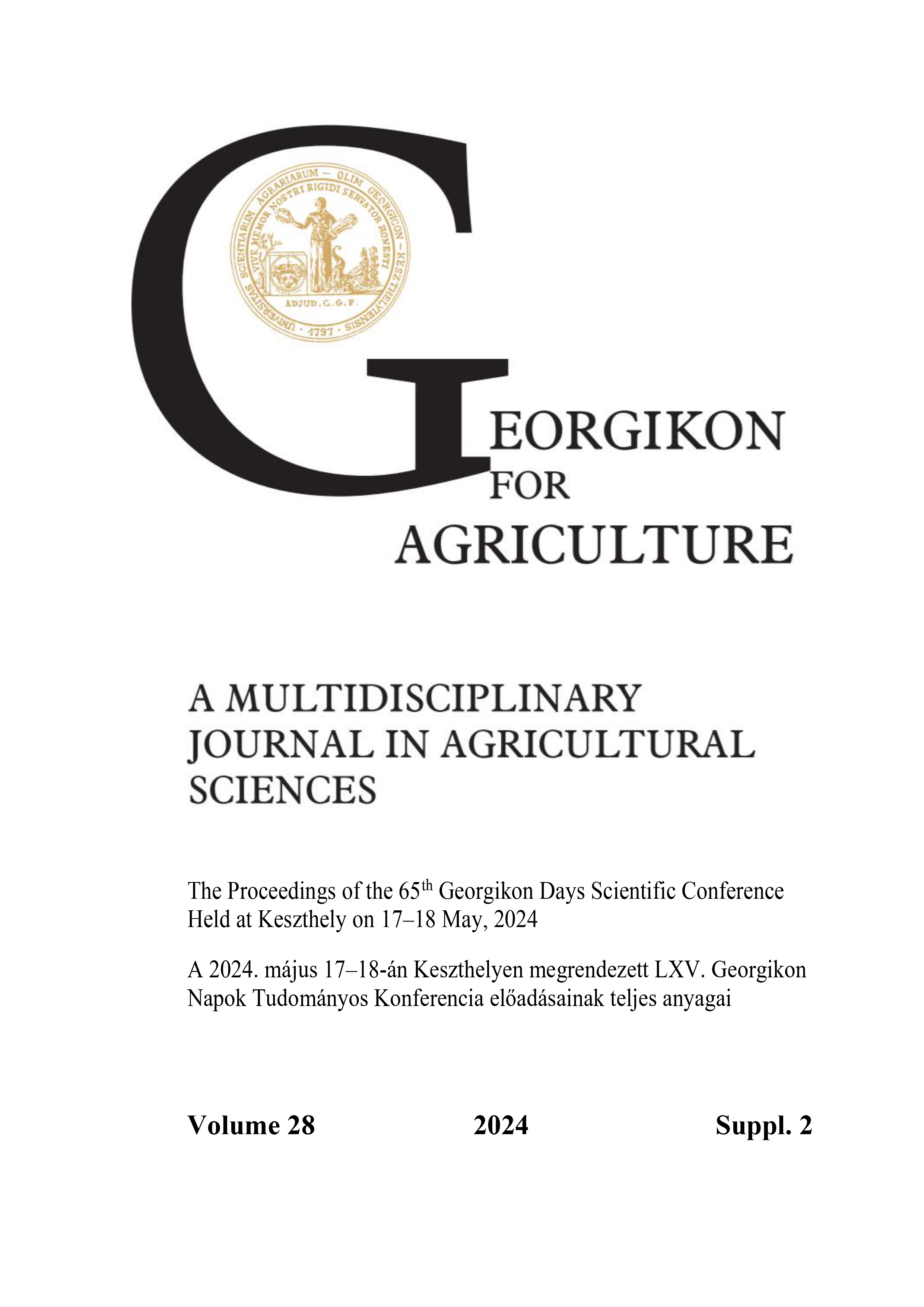Az invazív allelopátiás kétszikű gyomok magjait megfertőző potenciális fitopatogén gombák azonosítása és előfordulása
Kulcsszavak:
Abutilon theophrasti, Datura stramonium, gyommagot fertőző gombák, morfológiai, magfertőzöttségAbsztrakt
A Datura stramonium és az Abutilon theophrasti a jelentősebb kétszikű gyomnövények közé tartoznak, amelyek erős versenyképességgel, növekedési és allelopátiás tulajdonságokkal rendelkeznek a kultúrnövényekkel szemben. A magvaikkal fennmaradó és terjedő potenciális fitopatogén gombákról kevés az információ áll rendelkezésre. A vizsgálat célja volt, hogy azonosítsuk azokat a fitopatogén gombanemzetségeket, amelyek a Datura stramonium és az Abutilon theophrasti magvain fennmaradhatnak és terjedhetnek. Az Abutilon theophrasti és a Datura stramonium magmintákat Keszthely környékének szántóterületeiről gyűjtöttük 2007-ben, 2010-ben, illetve 2009-ben és 2010-ben. A magokon Fusarium spp., Alternaria spp., valamint az Aspergillus spp. gombák jelenlétét igazoltuk fénymikroszkóp segítségével. Az Alternaria spp. fertőzöttség 43,25%, az Aspergillus spp. 11,75% és a Fusarium spp. 4,25% volt. A Datura stramonium és az Abutilon theophrasti talajban lévő magjai hozzájárulhatnak a Fusarium spp, Alternaria spp és Aspergillus spp fajok fennmaradásához és terjedéséhez.
Hivatkozások
Blagojević, J., Janjatović, S., Ignjatov, M., Trkulja, N., Gašić, K., Ivanović. 2019. First Report of a Leaf Spot Disease Caused by Alternaria protenta on the Datura stramonium in Serbia. 104 (3) Https://Doi.Org/10.1094/PDIS-06-19-1335-PDN
Dafaallah, A. B. 2019. Allelopathic Effects of Jimsonweed (Datura Stramonium L.) Seed on Seed Germination and Seedling Growth of Some Leguminous Crops. Article in International Journal of Innovative Approaches in Agricultural Research. 3 (2) 321–331. https://doi.org/10.29329/ijiaar.2019.194.17
Ekwealor, K. U., Echereme, C. B., Ofobeze, T. N., Okereke, C. N. 2019. Economic Importance of Weeds: A Review. Asian Plant Research Journal, 3 (2) 1–11. https://doi.org/10.9734/aprj/2019/v3i230063
Follak, S., Schleicher, C., Schwarz, M., Essl, F. 2017. Major emerging alien plants in Austrian crop fields. Weed Research, 57 (6), 406–416. https://doi.org/10.1111/WRE.12272
Karimmojeni, H., Rahimian, H., Alizadeh, H., Yousefi, A. R., Gonzalez-Andujar, J. L., Mac Sweeney, E., Mastinu, A. 2021. Competitive Ability Effects of Datura stramonium L. and Xanthium strumarium L. on the Development of Maize (Zea mays) Seeds. Plants 2021, 10 (9) 1922. https://doi.org/10.3390/plants10091922
Kirkpatrick, B. L., Bazzaz, F. A. 1979. Influence of certain fungi on seed germination and seedling survival of four colonizing annuals. Conditions Journal of Applied Ecology 16 (2) 515–527. https://doi.org/10.2307/2402526
Kremer, R. J. 1986. Microorganisms Associated with Velvetleaf (Abutilon theophrasti) Seeds on the Soil Surface. Weed Science, 34 (2), 233–236. https://doi.org/10.1017/S0043174500066728
Kremer, R. J. 1987. Identity and Properties of Bacteria Inhabiting Seeds of Selected Broadleaf Weed Species. Microb Ecol. 14, 29–37. https://doi.org/10.1007/BF02011568
Kremer, R. J., Hughes, L. B., & Aldrich, R. J. 1984. Examination of Microorganisms and Deterioration Resistance Mechanisms Associated with Velvetleaf Seed1. Agronomy Journal, 76 (5) 745–749. https://doi.org/10.2134/AGRONJ1984.00021962007600050009X
Loddo, D., Bozic, D., Calha, I. M., Dorado, J., Izquierdo, J., Šćepanović, M., Barić, K., Carlesi, S., Leskovsek, R., Peterson, D., Vasileiadis, V. P., Veres, A., Vrbničanin, S., & Masin, R. 2019. Variability in seedling emergence for European and North American populations of Abutilon theophrasti. Weed Research, 59 (1) 15–27. https://doi.org/10.1111/WRE.12343
Malavika Dadlani, & Devendra K. Yadava (Eds.). 2023. Seed Science and Technology: Biology, Production, Quality. https://doi.org/10.1007/978-981-19-5888-5
Nishikawa, J., Kobayashi, T., Shirata, K., Chibana, T., & Natsuaki, K. T. 2006. Seedborne fungi detected on stored solanaceous berry seeds and their biological activities. Journal of General Plant Pathology, 72 (5) 305–313. https://doi.org/10.1007/s10327-006-0289-5
Novak R., Dancza I., Szentey L., Karaman J. 2014. Arable weeds of Hungary. Agronomie 25 (1) 109–121. https://doi.org/10.1051/agro:2004061
Oliveira, E. F. de, Santos, P. R. R. dos, Santos, G. R. 2018. Seeds of weeds as an alternative host of phytopathogens. Arquivos Do Instituto Biológico, 85 1–7. https://doi.org/10.1590/1808-1657000972017
Postic, J., Cosic, J., Vrandecic, K., Jurkovic, D., Saleh, A. A., & Leslie, J. F. 2012. Diversity of Fusarium Species Isolated from Weeds and Plant Debris in Croatia. Journal of Phytopathology, 160 (2) 76–81. https://doi.org/10.1111/J.1439-0434.2011.01863.X
Rojas-Sandoval, J. 2022. Abutilon theophrasti (velvet leaf). https://doi.org/10.1079/cabicompendium.1987
Tian, M., Li, Q., Zhao, W., Qiao, B., Shi, S., Yu, M., Li, X., Li, C., & Zhao, C. (2022). Potential Allelopathic Interference of Abutilon theophrasti Medik. Powder/Extract on Seed Germination, Seedling Growth and Root System Activity of Maize, Wheat and Soybean. Agronomy, 12 (4) 844. https://doi.org/10.3390/agronomy12040844
Warwick, S. I., Black, L. D. 2011., Neatby Bldg, W., Er-perimental Farm, C., Canada KIA, OC6. The Biology of Canadian Weeds.: 90. Abutilon theophrasti. Canadian Journal of Plant Science, 68 (4) 1069–1085. https://doi.org/10.4141/cjps88-127
Letöltések
Megjelent
Folyóirat szám
Rovat
License
Copyright (c) 2024 Simon Okwangan, Kelvin Kiprop, Evans Duah Agyemang, Rita Ofosu, György Pásztor, András Péter Takács

This work is licensed under a Creative Commons Attribution-NonCommercial-NoDerivatives 4.0 International License.
The articel is under the Creative Commons 4.0 standard licenc: CC-BY-NC-ND-4.0. Under the following terms: You must give appropriate credit, provide a link to the license, and indicate if changes were made. You may do so in any reasonable manner, but not in any way that suggests the licensor endorses you or your use. You may not use the material for commercial purposes. If you remix, transform, or build upon the material, you may not distribute the modified material. You may not apply legal terms or technological measures that legally restrict others from doing anything the license permits.




 Georgikon for Agriculture
Georgikon for Agriculture